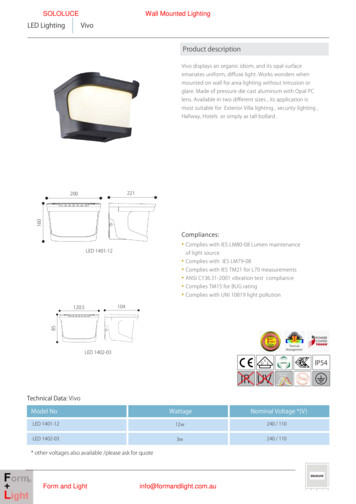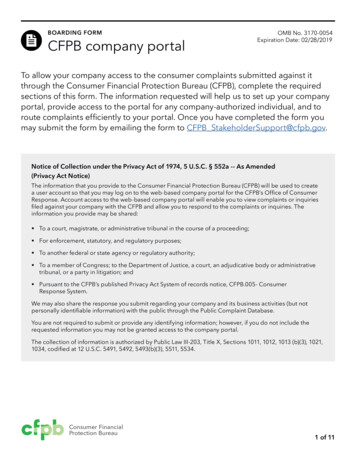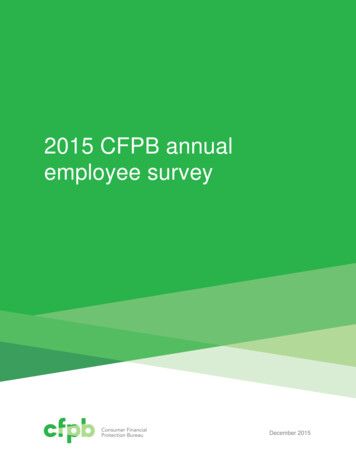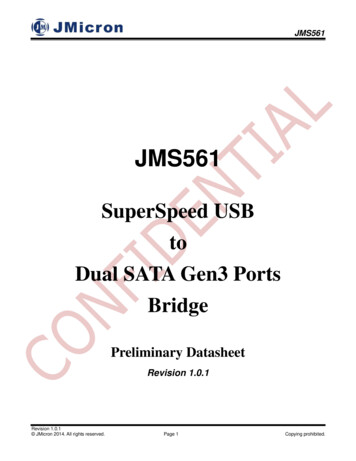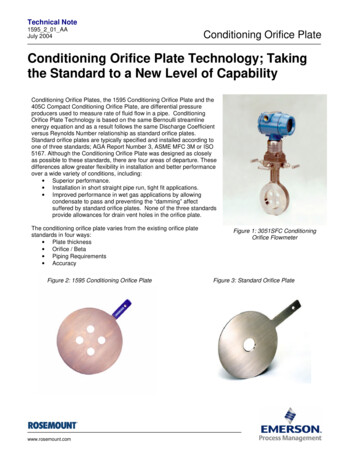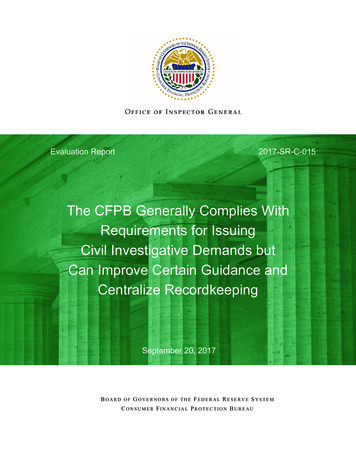
Transcription
Evaluation Report2017-SR-C-015The CFPB Generally Complies WithRequirements for IssuingCivil Investigative Demands butCan Improve Certain Guidance andCentralize RecordkeepingSeptember 20, 2017BOARD OF GOVERNORS OF THE FEDERAL RESERVE SYSTEMCONSUM ER FIN ANC IAL PR OTEC TION B UR EAU
Report ContributorsDaniel Novillo, OIG ManagerRachael Young and Sopeany Keo, Project LeadsMelissa Dorow, AuditorJordan Bressman, Audit InternCaitlin Romano, AttorneyMichael VanHuysen, Senior OIG Manager for Supervision and RegulationMelissa Heist, Associate Inspector General for Audits and EvaluationsAbbreviationsCFPBConsumer Financial Protection BureauCIDcivil investigative demandDodd-Frank ActDodd-Frank Wall Street Reform and Consumer Protection ActFTCFederal Trade Commissioninvestigation rulesRules Relating to InvestigationsLDLitigation DeputyOIGOffice of Inspector General
Executive Summary:The CFPB Generally CompliesWith Requirements for IssuingCivil Investigative Demands butCan Improve Certain Guidance andCentralize Recordkeeping2017-SR-C-015September 20, 2017PurposeFindingsWe conducted this evaluation to assessthe Consumer Financial ProtectionBureau’s (CFPB) adherence to its policiesand procedures for issuing civilinvestigative demands (CIDs) and itsgeneral compliance with the requirementsin section 1052(c) of the Dodd-FrankWall Street Reform and ConsumerProtection Act (Dodd-Frank Act).Specifically, our review determinedwhether the sampled CIDs contained theprocedural elements required by theDodd-Frank Act, including, but notlimited to, the presence of certaininformation such as notifications ofpurpose, return dates, and custodians.We found that the CFPB generally complied with the procedural elements ofsection 1052(c) of the Dodd-Frank Act and with the agency’s procedures whenissuing the sampled CIDs, but the agency can improve its guidance for craftingnotifications of purpose associated with CIDs. During our review, we learned thatin accordance with internal guidance, a CID’s notification of purpose is identical tothe statement of purpose in the associated investigation’s opening memorandum,which may be revised later in the investigation. Internal guidance calls for broadstatements of purpose, to allow for flexibility. The guidance does not expresslyremind enforcement attorneys of the need for statements of purpose to be compliantwith relevant case law on notifications of purpose, including any developments insuch case law, or remind them to revisit the statement of purpose in a revisedopening memorandum if the purposes of the investigation evolve. A potentiallynoncompliant notification of purpose may limit the recipient’s ability to understandthe basis for requests and thereby heighten the risk that the CID may face a legalchallenge. In the event of such a challenge, the CFPB’s ability to obtain theinformation needed to enforce consumer financial protection laws could be delayed,irrespective of the court’s decision. Additionally, noncompliant notifications ofpurpose pose a reputational risk, potentially affecting interactions with CIDrecipients and other stakeholders. During the course of our review, the CFPBupdated its internal policies to mitigate this potential risk.BackgroundThe Dodd-Frank Act authorizes the CFPBto take appropriate enforcement actions toaddress violations of federal consumerfinancial laws; the CFPB’s Office ofEnforcement performs this enforcementfunction and conducts investigations toensure that financial institutions complywith such laws. The Office ofEnforcement uses CIDs to obtaininformation from entities subject to aninvestigation or from third parties thatmay have relevant information. A CID isan official demand for documentarymaterial, tangible things, reports, answersto written questions, or oral testimony; ifnecessary, a CID can be enforced infederal court. Requirements contained insection 1052(c) of the Dodd-Frank Actand the agency’s procedures govern howthe agency should issue CIDs.We also found that the CFPB can improve its matter management system.Specifically, we found that the Office of the Executive Secretariat does not appearto maintain a complete record of all petitions and supporting documents. Inaddition, the Office of Enforcement does not use a centralized repository tomaintain CIDs and related documentation; rather, the agency maintains CIDdocumentation on the shared drives of multiple offices. Thus, CID documentationis not maintained in an easily retrievable manner.RecommendationsOur report contains a recommendation to improve the Office of Enforcement’spractices for crafting notifications of purpose for CIDs to reduce the risk thatnotifications of purpose may result in legal challenges from CID recipients. Ourreport also contains recommendations for the agency to implement a centralizedmatter management system to ensure that official federal records are easilyretrievable. In its response to our draft report, the CFPB concurs with ourrecommendations. The agency describes completed and planned actions to addressour recommendations.
Summary of Recommendations, OIG Report 2017-SR-C-015Finding 1: The CFPB Generally Complies With the Procedural Requirements of theDodd-Frank Act and Internal Requirements for Issuing CIDs but Can Improve theGuidance for Crafting Notifications of PurposeNumber1RecommendationRevise the Policies and Procedures Manual to expresslyremind litigation teams that statements of purpose mustcomply with relevant case law on notifications of purpose,including any developments in such case law, and remind theteams to revisit the statement of purpose in a revised openingmemorandum if the purposes of the investigation evolve.Responsible officeOffice of EnforcementFinding 2: The CFPB’s Matter Management System Could Be ImprovedNumberRecommendationResponsible office2Coordinate with other CFPB divisions to identify andimplement a centralized matter management system thatfacilitates the retrieval of civil investigative demanddocumentation while ensuring that access to high-sensitivityinformation is limited in accordance with the CFPB’s policiesand procedures.Office of Enforcement3Ensure that the Office of the Executive Secretariat follows itsestablished records file plan and develops a process formaintaining civil investigative demand documentation,including petitions to modify or set aside civil investigativedemands, so that official federal records and relatedsupporting documents are easily retrievable.Office of the ExecutiveSecretariat
September 20, 2017MEMORANDUMTO:Anthony AlexisAssistant Director, Office of EnforcementConsumer Financial Protection BureauGena ChiecoExecutive Secretary and Counsel to the Director, Office of the Executive SecretariatConsumer Financial Protection BureauFROM:Melissa HeistAssociate Inspector General for Audits and EvaluationsSUBJECT:OIG Report 2017-SR-C-015: The CFPB Generally Complies With Requirements forIssuing Civil Investigative Demands but Can Improve Certain Guidance and CentralizeRecordkeepingWe have completed our report on the subject evaluation. We conducted this evaluation to assess theConsumer Financial Protection Bureau (CFPB) Office of Enforcement’s (1) adherence to its policies andprocedures for issuing CIDs and (2) general compliance with the requirements in section 1052(c) of theDodd-Frank Wall Street Reform and Consumer Protection Act.We provided you with a draft of our report for review and comment. In your response, you concur withour recommendations and outline completed and planned actions to address our recommendations. Wehave included your response as appendix C to our report.We appreciate the cooperation that we received from the Office of Enforcement and the Office of theExecutive Secretariat. Please contact me if you would like to discuss this report or any related issues.cc:Christopher D’Angelo, Associate Director, Division of Supervision, Enforcement, and Fair LendingDavid Bleicken, Deputy Associate Director, Division of Supervision, Enforcement, and FairLendingJohn Coleman, Deputy General Counsel for Litigation and Oversight, Legal DivisionJoanna Pearl, Chief of Staff, Office of EnforcementDana James, Acting Chief Financial Officer and Assistant Director, Office of the ChiefFinancial Officer
ContentsIntroduction . 1Objectives . 1Background . 1The CFPB’s Office of Enforcement . 1The CFPB’s Statutory CID Authority and Agency Policies and Procedures . 3The Office of Enforcement’s Process for Issuing and Modifying CIDs. 4The CID Petition Process . 5Finding 1: The CFPB Generally Complies With the ProceduralRequirements of the Dodd-Frank Act and Internal Requirements forIssuing CIDs but Can Improve the Guidance for Crafting Notifications ofPurpose .7The CFPB Generally Complies With the Dodd-Frank Act Requirements forIssuing CIDs . 7The CFPB Can Improve Its Guidance for Crafting Notifications of Purpose . 8The CFPB Generally Complies With Policies and Procedures for Issuing CIDs. 9The CFPB’s Approach to Assessing the Burden Associated With Respondingto CIDs . 10The Investigation Rules Require Senior Official Approval to Issue CIDs,and Guidance Requires Staff to Consider Burden . 10The CFPB Uses Modifications and Extensions of Time to Help AlleviatePotential Burden. 10The CFPB’s Approach to Posting Petitions Publicly. 11Management Actions Taken . 12Recommendation . 12Management’s Response . 12OIG Comment . 12Finding 2: The CFPB’s Matter Management System Could Be Improved . 13The CFPB Can Improve Its Recordkeeping of Petitions to Modify orSet Aside a CID . 13Storage Across Multiple Divisions and Various Shared Drives Results inDifficulties Retrieving CID Documentation . 14The CFPB Has Established Requirements and Other Agency Practices forPreserving CID Records . 14The CFPB Would Benefit From a Centralized Approach to Managing CIDRecords . 14Management Actions Taken . 15Recommendations. 15Management’s Response . 15OIG Comment . 16
Appendix A: Scope and Methodology . 17Appendix B: Applicable Requirements of Section 1052(c)of the Dodd-Frank Act. 18Appendix C: Management’s Response . 20
IntroductionObjectivesWe conducted an evaluation of the Consumer Financial Protection Bureau’s (CFPB) processesfor issuing civil investigative demands (CIDs). Our objectives were to assess the CFPB’s(1) adherence to its policies and procedures for issuing CIDs and (2) general compliance withthe requirements in section 1052(c) of the Dodd-Frank Wall Street Reform and ConsumerProtection Act (Dodd-Frank Act).We judgmentally selected a sample of CIDs from 2013 to 2015 and reviewed the relateddocumentation. We also interviewed officials from the Federal Trade Commission (FTC) andthe U.S. Department of Justice, two federal agencies with similar CID authority, and comparedtheir CID processes to the CFPB’s processes. Details on our scope and methodology are inappendix A.BackgroundThe Dodd-Frank Act established the CFPB to regulate the offering and provision of consumerfinancial products and services under federal consumer financial laws. With respect to theenforcement of those laws, the Dodd-Frank Act grants the CFPB certain authorities to(1) conduct investigations and (2) obtain information to aid those investigations by issuingCIDs. A CID is a tool used by the CFPB’s Office of Enforcement to obtain information fromentities subject to an investigation or from third parties that may have relevant information. ACID is an official demand for documentary material, tangible things, reports, answers to writtenquestions, or oral testimony; if necessary, the CFPB can seek to enforce a CID in federal court.From October 1, 2016, through March 31, 2017, the agency announced enforcement actionsrequiring approximately 200 million in total relief for consumers who fell victim to variousviolations of consumer financial protection laws. The CFPB generally does not publicize detailsabout ongoing investigations, including CIDs, until the agency files a public enforcementaction. However, the CFPB does publish petitions to modify or set aside CIDs and the ordersresolving those petitions. 1The CFPB’s Office of EnforcementThe Office of Enforcement is one of four offices in the Division of Supervision, Enforcement,and Fair Lending, and one of two CFPB offices responsible for investigating potential violations1.See the CFPB’s Rules Relating to Investigations, 12 C.F.R. 1080.6(g).2017-SR-C-0151
of federal consumer financial laws. 2 The office investigates potential violations of federalconsumer financial laws by companies or individuals that offer or provide consumer financialproducts or services and issues enforcement actions when appropriate.The Office of Enforcement includes four litigation teams, each led by a Litigation Deputy (LD)and two Assistant Litigation Deputies and staffed by 20–22 attorneys and 3–4 paralegals. Thepolicy and strategy team and the Front Office staff provide strategic direction and support forthe litigation teams. The office’s professional support staff includes investigators, forensicaccountants, statisticians, and eDiscovery staff (figure 1). 3Figure 1: Organizational Structure of the Office of EnforcementAssistantDirector for theOffice ofEnforcementPrincipalNameDeputyTitleChief of nDeputyLitigationDeputyLitigationDeputyPolicy andStrategyDeputyDeputy iesAssistantLitigationDeputiesPolicy andStrategyAssistantDeputyeLawSupervisorlitigation teamlitigation teamlitigation teamlitigation teampolicy andstrategy teamSupervisoryInvestigatorprofessionalsupport teamSource: Developed by the OIG based on a review of the CFPB’s organization charts.Note: This organization chart is not comprehensive and includes only details relevant to this evaluation.2.The CFPB’s Office of Fair Lending and Equal Opportunity also conducts investigations of potential violations of federalconsumer financial laws, specifically related to fair lending.3.E-discovery is the process of identifying, preserving, collecting, reviewing, analyzing, and producing electronically storedinformation in response to a government investigation or during administrative, civil, or criminal legal actions.2017-SR-C-0152
The CFPB’s Statutory CID Authority and Agency Policies andProceduresSection 1052(c) of the Dodd-Frank Act provides the CFPB with the authority to issue andenforce CIDs. 4 The act also outlines a series of procedural requirements for CIDs. It states thatthe CFPB may issue a CID to any person who may have information relevant to a violation offederal consumer financial law. The statute states that each CID must “state the nature of theconduct constituting the alleged violation which is under investigation and the provision of lawapplicable to such violation.” See appendix B for the specific statutory requirements for issuingand enforcing CIDs described in section 1052(c) of the Dodd-Frank Act.In June 2012, the CFPB adopted its final Rules Relating to Investigations (investigation rules),which describes its procedures for conducting investigations under section 1052 of the DoddFrank Act. 5 The investigation rules set forth the CFPB’s authority to conduct investigations andthe rights of persons from whom the agency seeks to compel information in investigations. Asthey relate to CIDs, the investigation rules restate many of the requirements included in theDodd-Frank Act and provide additional details on issuing, modifying, and enforcing a CID.Additionally, the investigation rules specify the procedures that recipients must follow whenpetitioning the CFPB Director to modify or set aside a CID. The CFPB modeled theinvestigation rules on the investigative procedures of other federal agencies with enforcementauthority, such as the FTC and the U.S. Securities and Exchange Commission.The Office of Enforcement’s Policies and Procedures Manual provides further internalguidance to staff for issuing, modifying, serving, and enforcing a CID. Among other topics, themanual outlines the agency’s expectations for drafting notifications of purpose. It states that thenotification of purpose for a CID should match the statement of purpose for an investigation,which is contained in the investigation’s opening memorandum, and the manual includesexamples of language for an investigation’s statement of purpose. The manual suggests thatstatements of purpose “describe the nature of the conduct and the potentially applicable law invery broad terms.”The manual also provides Office of Enforcement staff with guidance for reducing the potentialburden of complying with a CID. It states that staff should consider the burden the CID willimpose on the recipient and carefully consider what requests for information to include in aCID. The manual further states that staff should (1) narrowly tailor a CID to solicit theinformation necessary for the investigation and (2) be amenable to working with the recipient tonarrow an issued CID so that it is consistent with the needs of the investigation.In addition to detailed guidance on the CID process, the Policies and Procedures Manual alsocontains guidance on maintaining matter files, including establishing a folder for CIDs andupdating the Office of Enforcement’s matter management system with information on eachCID. The manual also includes hyperlinks to a CID-related form and templates.4.The FTC and the U.S. Department of Justice are two other federal agencies with CID authority.5.The CFPB’s Rules Relating to Investigations can be found at 12 C.F.R. § 1080.6 (2017).2017-SR-C-0153
The Office of Enforcement’s Process for Issuing and Modifying CIDsOffice of Enforcement litigation teams may issue one or more CIDs to companies andindividuals after opening an investigation to obtain information relevant to the alleged violationof law that is under investigation. The litigation team working on a particular investigation maydemand that the subject of the investigation or a third party produce documents, tangible things,written reports, answers to questions, and oral testimony. Using templates to assist in drafting aCID, the litigation team considers what information to request and the burden those requestsmight impose on the recipient. The litigation team sends the draft CID to the AssistantLitigation Deputy and the LD for review and feedback. The LD signs the CID to indicate finalapproval, and the litigation team issues the CID package to the recipient. 6The investigation rules require the CID recipient to meet and confer with the CFPB’s litigationteam within 10 days of the agency serving the CID unless the LD waives the meet and conferrequirement. During the meet and confer, the litigation team addresses the recipient’s requestsfor modifications or extensions; discusses any potential production of personally identifiableinformation; and inquires about the recipient’s information management systems, organizationalstructure, and document retention policies. Following the meet and confer, the recipient maysubmit in writing a request for modification of the CID terms or a request for an extension oftime to respond. The litigation team memorializes any proposed agreement in a letter for finalapproval and signature by the LD. Upon submitting the requested materials, the recipientcertifies compliance with the CID under a sworn certificate, attesting that all the requestedinformation in the recipient’s possession, custody, or control has been produced. 7 This processis depicted in figure 2.Figure 2: The CID Process With Request to Modify and ExtendSource: Developed by the OIG based on a review of the Office of Enforcement’s CID process.Note: This figure depicts the CID process in the absence of a petition to the CFPB Director to modify or set aside theCID. A CID recipient may request a modification or an extension of time from the litigation team, which is distinct from apetition to the CFPB Director to modify or set aside the CID.6.A CID package may include the following, as appropriate: the signed CID form, CID definitions and instructions,certificates of compliance, the business records certificate, document submission standards, the investigation rules, thecertificate of compliance with the Right to Financial Privacy Act, and the notice to persons supplying information.7.If a CID recipient fails to comply with a CID, the litigation team may seek enforcement in federal district court.2017-SR-C-0154
The CID Petition ProcessThe recipient may file a petition to modify or set aside a CID within 20 days of service or by thereturn date if that date is less than 20 days from the date of service. The CFPB Director rules onpetitions to modify or set aside CIDs. The CFPB typically publishes petitions to modify or setaside CIDs and the Director’s orders resolving those petitions. A petitioner may requestconfidential treatment of all or part of a petition.The CFPB’s internal process for responding to petitions to modify or set aside CIDs, which wasupdated in January 2017, aims to complete the CFPB’s response to a petition withinapproximately 30–40 calendar days from the filing of a petition. 8 In January 2017, the CFPBmade the following key changes to its process: The Legal Division, rather than the Office of Enforcement, now drafts a memorandumto the Director about the disposition of the petition, because the issues raised bypetitions are largely legal in nature. In addition, this change allows Office ofEnforcement staff to focus on their other investigatory or enforcement work, so as notto delay resolution of the petition. The Director now decides on requests for confidential treatment of a petition. When theCFPB transferred this responsibility to the Director from the Associate Director for theDivision of Supervision, Enforcement, and Fair Lending, the CFPB also eliminated theoption for petitioners to withdraw a petition due to denial of confidential treatment.Instead, after serving the CFPB Director’s order to a petitioner, the CFPB will delaypublishing the petition and the Director’s order for at least 5 business days to allow thepetitioner an opportunity to seek a court order preventing any proposed disclosure of analleged trade secret or other information that the CFPB cannot lawfully disclose.9 Under the current approach, the Director’s final order on the petition includes anydecisions pertaining to confidentiality. Under prior procedures, decisions onconfidentiality requests and the merits of the related petition occurred sequentially,sometimes delaying the resolutions of petitions that included a request for confidentialtreatment. The Office of Enforcement litigation team reviews the petition for information that theCFPB may have good cause to redact and recommends any redactions regardless ofwhether the petitioner has made a request for confidential treatment.As stated in the investigation rules, a petitioner must file any petition to modify or set aside aCID with the CFPB’s Executive Secretary. The Office of the Executive Secretariat isresponsible for docketing petitions and coordinating the agency’s responses to petitions. This8.The CFPB benchmarked against the FTC’s process for responding to petitions and noted that the FTC must comply with aregulatory requirement to resolve all petitions within 40 days of the filing date. Although the CFPB does not have asimilar regulatory requirement, the agency based its target time frame on this benchmark.9.As discussed above, the FTC’s CID authority is similar to the CFPB’s. Comparatively, the FTC does not have a processwhereby petitioners can request confidentiality for an entire petition; rather, a petitioner can request confidential treatmentof certain data and information, but the redacted petition is public record. The CFPB has not granted in full any requestsfor confidential treatment. Three requests were granted in part.2017-SR-C-0155
office is also responsible for notifying the petitioner if the agency will not address the petitionfor cases in which the petition seeks unavailable relief or review. 10The Office of the Executive Secretariat prepares the CFPB Director’s daily briefing book,which includes memorandums and proposed orders prepared by the Legal Division that supportthe Director in deciding on which petitions to modify or set aside CIDs. Once the Director ruleson a petition and any accompanying confidentiality request, the Office of the ExecutiveSecretariat serves the order on the petitioner. The order includes a notice that the public versionof the petition will be published on the CFPB’s public website no fewer than 5 business daysafter the order is served on the petitioner, unless the CFPB determines that there is good causeto avoid publication. An FTC official noted that the FTC engages in a similar practice byproviding notice before publishing a petition so the petitioner can seek a court order.10. A petition submitted pursuant to 12 C.F.R. § 1080.6(e) must seek relief or request review on grounds available under12 U.S.C. § 5562(f) or 12 C.F.R. § 1080.6(e).2017-SR-C-0156
Finding 1: The CFPB Generally Complies With theProcedural Requirements of the Dodd-Frank Act andInternal Requirements for Issuing CIDs but Can Improvethe Guidance for Crafting Notifications of PurposeWe found that the CFPB generally complied with the procedural elements of section 1052(c) ofthe Dodd-Frank Act and the agency’s procedures when issuing the sampled CIDs, but theagency can improve its guidance for crafting notifications of purpose associated with CIDs. 11Section 1052(c) of the Dodd-Frank Act sets forth the CFPB’s statutory requirements for issuinga CID, including that the notification of purpose shall state the nature of the conductconstituting the alleged violation under investigation and the provision of law applicable to suchviolation. The investigation rules describe the CFPB’s procedures to carry out the requirementsin section 1052(c) of the Dodd-Frank Act and specify additional policies and procedures relatedto revising CID terms and petitions to modify or set aside CIDs. The Office of Enforcement’sPolicies and Procedures Manual aligns with the policies and procedures outlined in theinvestigation rules and provides further guidance to Office of Enforcement employees regardingthe CID process. According to the Policies and Procedures Manual, a CID’s notification ofpurpose is identical to the statement of purpose in the associated investigation’s openingmemorandum, which may be revised later in the investigation.The Policies and Procedures Manual calls for a broad statement of purpose. The guidance doesnot expressly remind enforcement attorneys of the need for statements of purpose to becompliant with relevant case law on notifications of purpose, including any developments insuch case law, or remind them to revisit the statement of purpose in a revised openingmemorandum if the purposes of the investigation evolve. A potentially noncompliantnotification of purpose may limit the recipient’s ability to understand the basis for requests andthereby heighten the risk that the CID may face a legal challenge. In the event of such achallenge, the CFPB’s ability to obtain the information needed to enforce consumer financialprotection laws could be delayed, irrespective of the court’s decision. Additionally,noncompliant notifications of purpose pose a reputational risk, potentially affecting interactionswith CID recipients and other stakeholders. During the course of our review, the Office ofEnforcement updated its internal policies to mitigate this potential risk.The CFPB Generally Complies With the Dodd-Frank ActRequirements for Issuing CIDsOur review indicates that the CFPB generally met th
maintaining civil investigative demand documentation, including petitions to modify or set aside civil investigative demands, so that official federal records and related supporting documents are easily retrievable. Office of the Executive Secretariat . September 20, 2017 .



